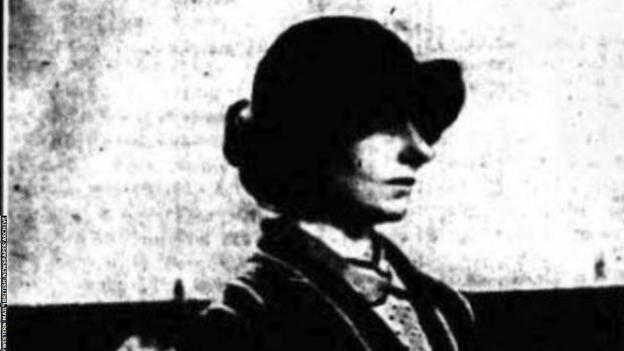
Join notifications to the most recent Perception options by way of the BBC Sport app and discover the newest within the sequence right here .
On a chilly, crisp February night beneath the duvet of darkness, a lady stealthily creeps in the direction of Wimbledon’s empty grandstands and pristine grass courts.
She climbs the hedge, carrying in her bag 5 tins of paraffin oil, a bundle of firelighters, a package deal of wooden shavings and two containers of matches.
She picks her spot, locations her bag on the courtroom and readies the substances – making ready to decimate one in all Britain’s most well-known sporting venues.
It is only one incident in a 12 months of protests at main sporting occasions; the most recent try to win hearts and minds on a difficulty that divides the nation and provokes anger on either side of the argument.
However the 12 months in query is 1913.
There’s one last merchandise within the lady’s bag – a bit of paper. On it’s written ‘No peace till ladies get the vote’.

“The suffragettes are the biggest home terror organisation who ever operated on British soil, they haven’t any equal,” says historian Dr Fern Riddell.
“They had been on one other scale to anything. There have been tons of and tons of of assaults, with tons of of individuals in jail and no one ever talks about that reality.”
Their trigger is healthier remembered than the strategies by which it was pursued.
Within the early a part of the 1800s, the considered ladies having the precise to vote in the UK was utterly alien to many.
In 1831, solely a tiny a part of British society – roughly 2% of the full inhabitants – could take part in parliamentary elections.
The next 12 months, the Reform Act prolonged the vote to extra males, however explicitly barred ladies from the polling sales space.
By the early twentieth Century, after 60 years of peaceable protests, handing out pamphlets and making well mannered requests to authorities to offer ladies the precise to vote, many members of girls’s suffrage actions had been rising drained and annoyed.
“There have been tons of people that did not assist suffrage – suffrage is a really difficult thought for lots of people, as weird as that will appear as we speak,” mentioned Dr Riddell, creator of Demise in Ten Minutes, a biography of suffragette bomber Kitty Marion.
“The concept of girls having the vote was not massively supported.”
The suffragettes determined they wanted to up the ante.
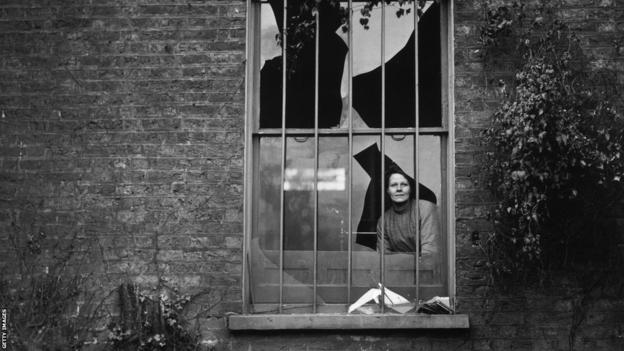
When folks consider the suffragettes, they doubtless consider marches and protests with banners, massive gatherings with leaders of the motion delivering speeches to rousing crowds, or ladies tying themselves to railings and refusing to maneuver.
And till round 1909, that’s what the suffragettes did.
However change was coming to the motion. The Girls’s Social and Political Union (WSPU) started in 1903, led by Emmeline Pankhurst. Its motto was “deeds not phrases” and shortly it discovered, having exhausted different routes, that violence was most persuasive.
Between 1912-1914 the suffragettes had been the biggest risk to home peace within the nation, with cells throughout the nation.
They carried out tons of of assaults aimed toward inflicting as a lot destruction and disruption as doable to on a regular basis life.
Pankhurst mentioned the WSPU’s goal was “to make England and each division of English life insecure and unsafe” by making a “reign of terror”.
By the top of 1912, 240 folks had been despatched to jail for militant suffragette actions.
Direct motion took the type of bombing MPs’ homes, inserting explosives in publish containers and finishing up arson assaults on public locations, akin to trains and church buildings.
Targets had been rigorously chosen primarily based on their significance to British life, so it’s no coincidence that a few of the suffragettes’ favoured marks had been additionally sporting venues.
“Sport is a big a part of English cultural life, if you are going to goal issues to carry your trigger to unusual folks, after all you are going to goal sport,” says Dr Riddell.
Golf and racecourses took the brunt of the assaults as a result of they had been incessantly empty, largely unguarded and, together with different sports activities premises, had been predominantly male-dominated arenas.
Golf membership members typically turned up for a morning spherical solely to find that intruders had spent the evening hacking up turf, throwing acid across the greens and carving the letters VW or Votes for Girls into the bottom.
A fireplace at Ayr racecourse precipitated £2,000 of harm whereas Hurst Park racecourse was burned down by Marion, a distinguished member of what grew to become generally known as the ‘younger scorching bloods’ – a section of the WSPU finishing up violent, direct motion.
Grandstands had been a preferred goal for arson assaults, they had been massive and the spectacle of 1 ablaze was sure to draw publicity.
A plot to burn down the Crystal Palace grandstand on the eve of the 1913 FA Cup last was foiled, however the grandstand of the Manor Floor soccer stadium in Plumstead – then house to Woolwich Arsenal – was attacked, inflicting £1,000 value of harm.
Many of those incidents have been forgotten or misplaced within the annals of time, however one has remained a landmark second with a tragic ending.
When Emily Davison stepped out in entrance of the King’s horse on the Epsom Derby in June 1913, it’s thought she meant to emblazon the horse with a suffragette banner so as to make a press release and, undoubtedly, the subsequent day’s entrance web page.
As a substitute, Davison died after being injured by the charging horse.
Queen Mary, sat with the King within the grandstand at Epsom, described Davison as a “horrid lady” in her journal later that night.
However Davison’s last motion paved the best way for progress.
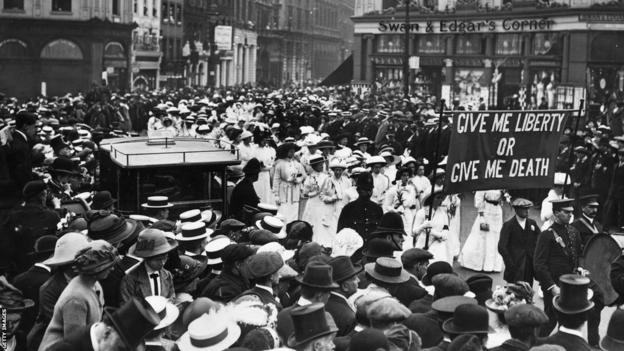
Davison visited Wimbledon on the day earlier than her fateful journey to the Epsom Derby.
The idea runs that she visited fellow suffragette and outdated buddy Rose Lamartine Yates, the dynamic chief of the WSPU’s Wimbledon department, so as to choose up the ‘Votes for Girls’ banners to wave on the course.
Wimbledon, the south-west London suburb, fairly than the tennis championships, had turn into a hotbed of suffragette exercise, lengthy earlier than the assault on the All England Membership.
Yates defied the authorities’ makes an attempt to outlaw her public appearances by talking each Sunday on Wimbledon Widespread, attracting crowds of as much as 20,000 folks.
One such assembly in March 1913 descended into chaos as 300 cops tried to forestall the suffragettes from gathering. The next week an anti-suffragette counter-protest used a motor horn and noxious hydrogen sulphide fuel to attempt to disrupt the audio system.
“A lot of you appear to suppose these conferences are prohibited,” Yates informed her detractors in April. “However till we’re knowledgeable of that reality we will not deprive you of the pleasure of listening to us.”
Yates wanted the assistance of mounted officers and a police cordon to return house as a mob of anti-suffragettes swirled round her.
An area ‘Retaliation League’ vowed that “each act of violence perpetrated by these ladies will probably be answered by assaults on the personal homes or properties of Militant Suffragettes” whereas ladies’s weekly journal The Gentlewoman branded them “a group of wildly irresponsible females”.
Winston Churchill, house secretary from between 1910 and 1911, was quoted as describing the suffragettes as “a band of foolish, neurotic, hysterical ladies”.
The police had been treating the suffragettes’ marketing campaign as a terrorist enterprise, however had been struggling to get it beneath any sort of management.
They tried desperately to determine and imprison any distinguished members of the get together who they suspected of finishing up bomb and arson assaults. A few of those that had been jailed would go on starvation strike to proceed their protest and had been force-fed.
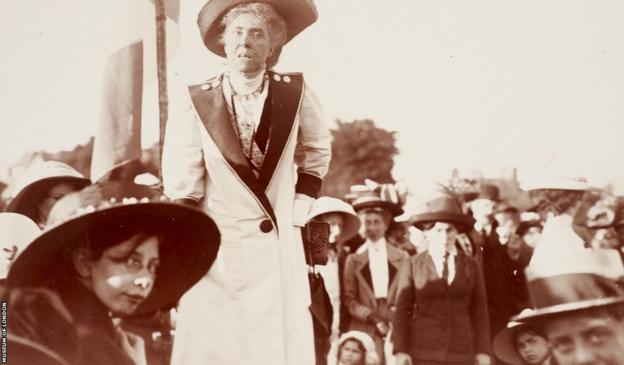
Yates herself had served a month in Holloway for obstruction throughout a suffragette march on Westminster. She hosted occasions celebrating the discharge of different prisoners of the trigger.
Whereas Wimbledon WSPU would nonetheless maintain summer season festivals the place hand-knitted kids’s garments had been on sale to lift cash, the marketing campaign’s extra direct motion alienated some among the many basic public.
“The second you goal unusual folks and disrupt unusual folks’s lives, assist is misplaced,” mentioned Dr Riddell.
“The second the suffragettes start bombing practice carriages and sporting venues and public locations that individuals would go and count on to get pleasure from time with their household, the general public assist turns into weaker.”
However the suffragette message remained clear: ‘No peace till ladies get the vote.’
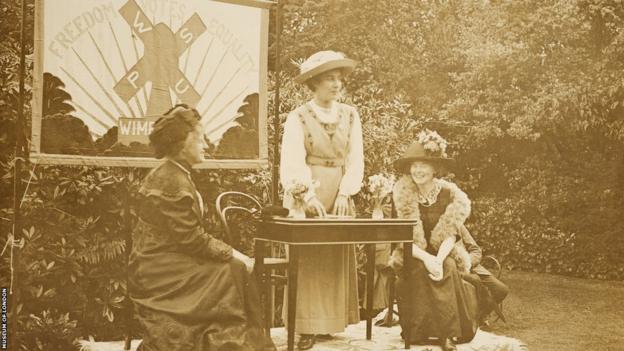
Again to that evening on the All England Membership in February 1913 and the lady making ready to burn down one of many Centre Courtroom stands – was she profitable?
Briefly, no.
The groundsman, Joseph Parsons, discovered the lady and, after she tried to run away however fell over, caught her and reported her to the police earlier than any injury was executed. The assault was foiled.
The unknown suffragette spoke solely as soon as, when charged on the police station to say “I object to being charged. I object to being detained right here.”
She appeared in courtroom, giving no particulars of herself – no title, age or homeland. Her identification stays unknown.
The lady, who newspapers on the time estimated to be round 35, was sentenced to 2 months in jail – a damning assertion from Parsons sufficient to seal her destiny.
Her silence in courtroom led some newspapers to dub her “the silent suffragette”.
Certainly, somebody knew who she was. Somebody like Yates.
“If Rose was not carrying these acts out herself, she would definitely pay attention to who was being despatched by the management of the WSPU into her territory to hold out these assaults,” mentioned Dr Riddell.
“Or it will have been somebody that she would have personally identified.”
The identification of the mysterious suffragette will doubtless by no means be identified, however her plot to set hearth to Wimbledon was one incident in an enormous operation which spanned a few years and dominated dialogue.
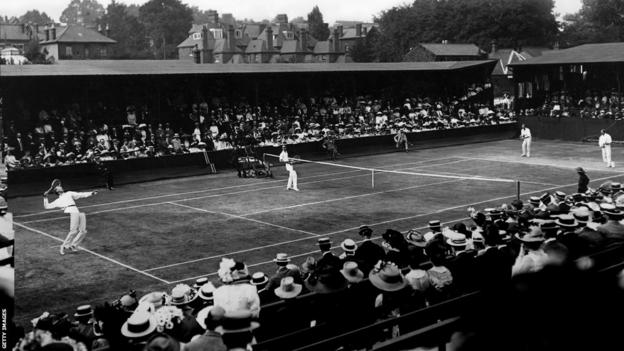
Ultimately, World Battle One broke out and the bombing marketing campaign was placed on maintain, a lot to the dismay of some members of the WSPU, together with Yates.
However the suffragettes needed to point out they might be affordable and useful, contributing to the struggle effort as an evolving technique within the combat towards inequality.
Girls over the age of 30 got the precise to vote after the struggle in 1918, but it surely was not till 1928 that British ladies received suffrage on the identical phrases as males, that’s, for ages 21 and older.
“The explanation ladies have the vote as we speak is partially due to the bombs,” mentioned Dr Riddell.
“When World Battle One ends there’s a very clear threat that the suffragettes will begin their bombing marketing campaign once more and the federal government and the Metropolitan Police, who’ve been unable to interrupt aside the bombing marketing campaign, cannot perceive who’s making the explosives and the place they’re coming from.
“They’re unable to manage, they’re terrified that the bombing goes to start out once more in a society that has been utterly traumatised by struggle.
“I do not suppose we’d have gotten the vote with out the bombs, with out the outbreak of struggle and the specter of the bombs coming again.”
Shortly after the struggle, the All England Membership additionally applied some adjustments, shifting from its Worple Street web site to the one it occupies as we speak on Church Street.
Bigger crowds had been the rationale behind the relocation. And one of many important attracts on the match was Frenchwoman Suzanne Lenglen, the primary ladies’s world primary, a six-time Wimbledon singles champion and maybe the primary feminine sporting famous person.
Progress on Centre Courtroom and off. The silent suffragette might not have succeeded on that February evening in 1913. She was on the unsuitable aspect of the legislation, however she proved to be on the precise aspect of historical past.

